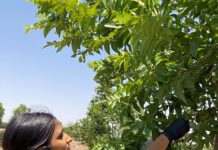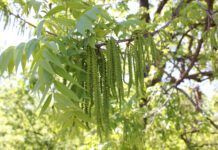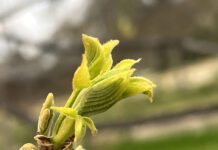
On-Farm Recharge (OFR) is a method in which growers flood farmlands during wet years when extra surface water is available to recharge and store the water in underlying aquifers for future use. Our previous research has shown that flooding a limited area leads to improved groundwater quality over time. Thus, OFR should be conducted on the same fields each year as needed to infiltrate available water.
To meet this goal and recharge as much water as possible, fields are subjected to extended flooding that can lead to low oxygen levels, which can be a major concern. In response, we have worked with growers to study OFR on crops such as almonds, pistachios and walnuts, and thus far have not observed adverse effects on tree health and productivity. This article focuses on project lessons and results from a pecan OFR pilot study that are applicable to other orchard systems. We discuss methods to increase recharge volumes, maintain soil oxygen levels and improve OFR cost efficiency.

Management to Increase Recharge Volumes
In 2019 and 2020, we conducted an OFR pilot study in a pecan orchard in the southern San Joaquin Valley. Pecan orchards are especially suited to OFR because pecans are facultative upland species able to tolerate saturated soils post-dormancy. The study was conducted on pecan plots with sandy loam soil in McFarland, Calif. (Figure 1). Plots were subjected to flooding for 39 to 46 days from early May to mid-June of 2019 and 2020. There were four treatments: continuous flooding (19W, 5.4 ac), alternating flooding between subplots (19E, 10 ac), over-irrigation (20E, 10.6 ac) and regular irrigation (20W, 23.5 ac). Originally, the orchard was flood irrigated; however, the existing concrete pipe system was not adequate to conduct the project. A junction to join the concrete pipe to a poly pipe system was extended across the south end of Field 19 to deliver flooding water (Figure 2A). Terraces were also installed in Field 19 to maintain more consistent water depths across the field. Silt fences (Figure 2B) and poly pipe dams (Figure 2C) were installed in 2019 and 2020. Both types of terraces slowed water flow and increased water levels as well increased wetted area.
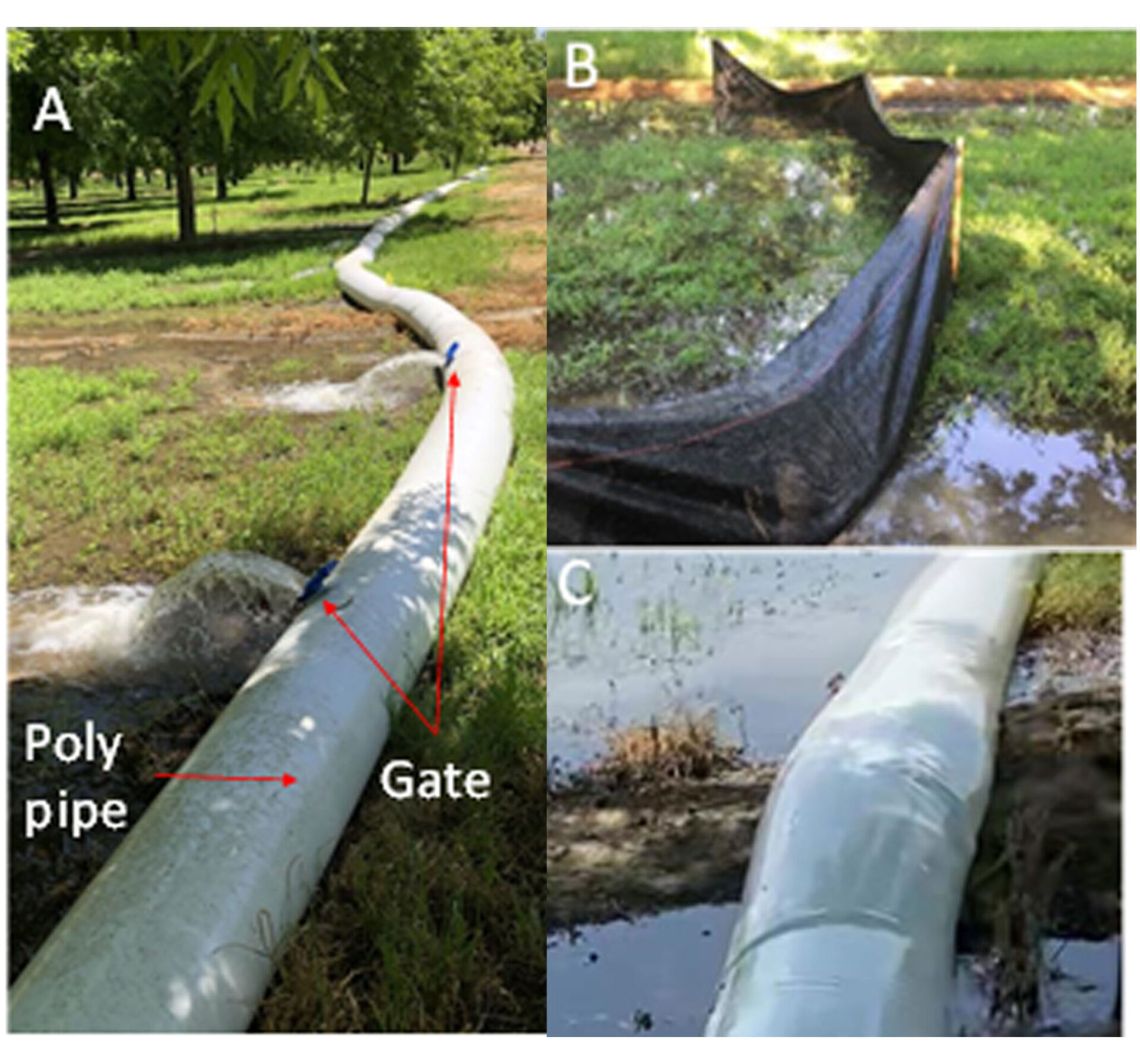
In 2020, the continuously flooded plot (19W) received a total of 40.7 feet of water, with 39.8 feet of water going to recharge (215 Ac-ft) as compared to 11.0 ft recharged in 2019. The volumes applied and recharged under continuous OFR treatment were higher than achieved under alternating OFR applications (19E), but both extended flooding OFR treatments achieved more recharge than the over-irrigation OFR treatment (Figure 3).
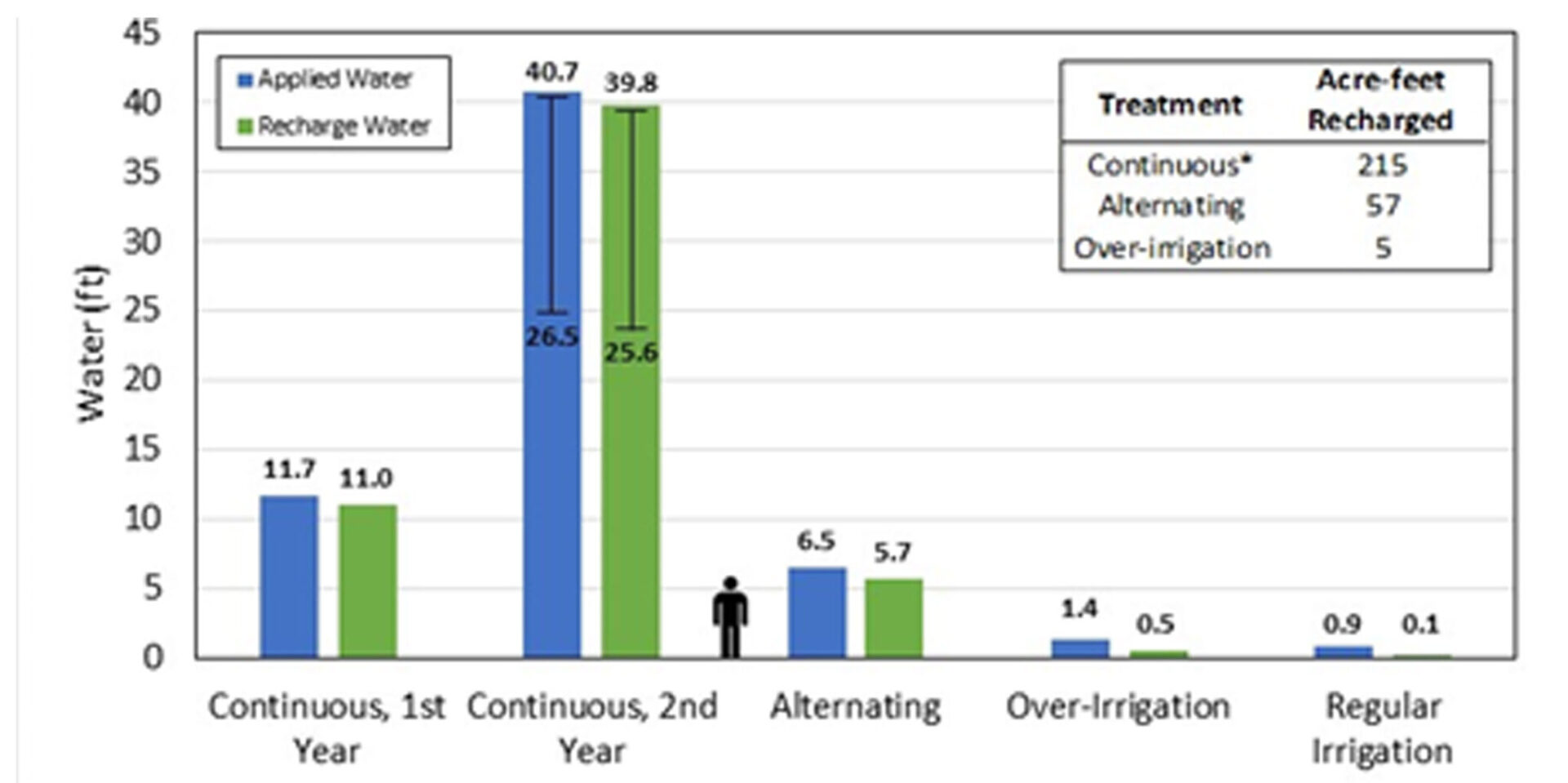
The continuous OFR treatment at 19W recharged approximately 3 times more water in 2020 than 2019, likely related to improved terracing. In 2019, silt fence terraces were installed about a month into OFR (with less than two weeks remaining.) In 2020, the grower terraced 19W with a more extensive series of poly pipe dams at the start of OFR. Terraces can allow more water inflow (and recharge) to a field because they can increase average water depth and wetted area, thereby increasing average infiltration rates. Figure 4, see left, summarizes the concept behind terracing and the table shows estimated wetted area by length and slope. Infiltration increased from about 4 in/day (without terraces) to almost 11 in/day (with terraces). The higher rate is similar to rates recorded at a nearby Switchfield recharge pond one mile east.
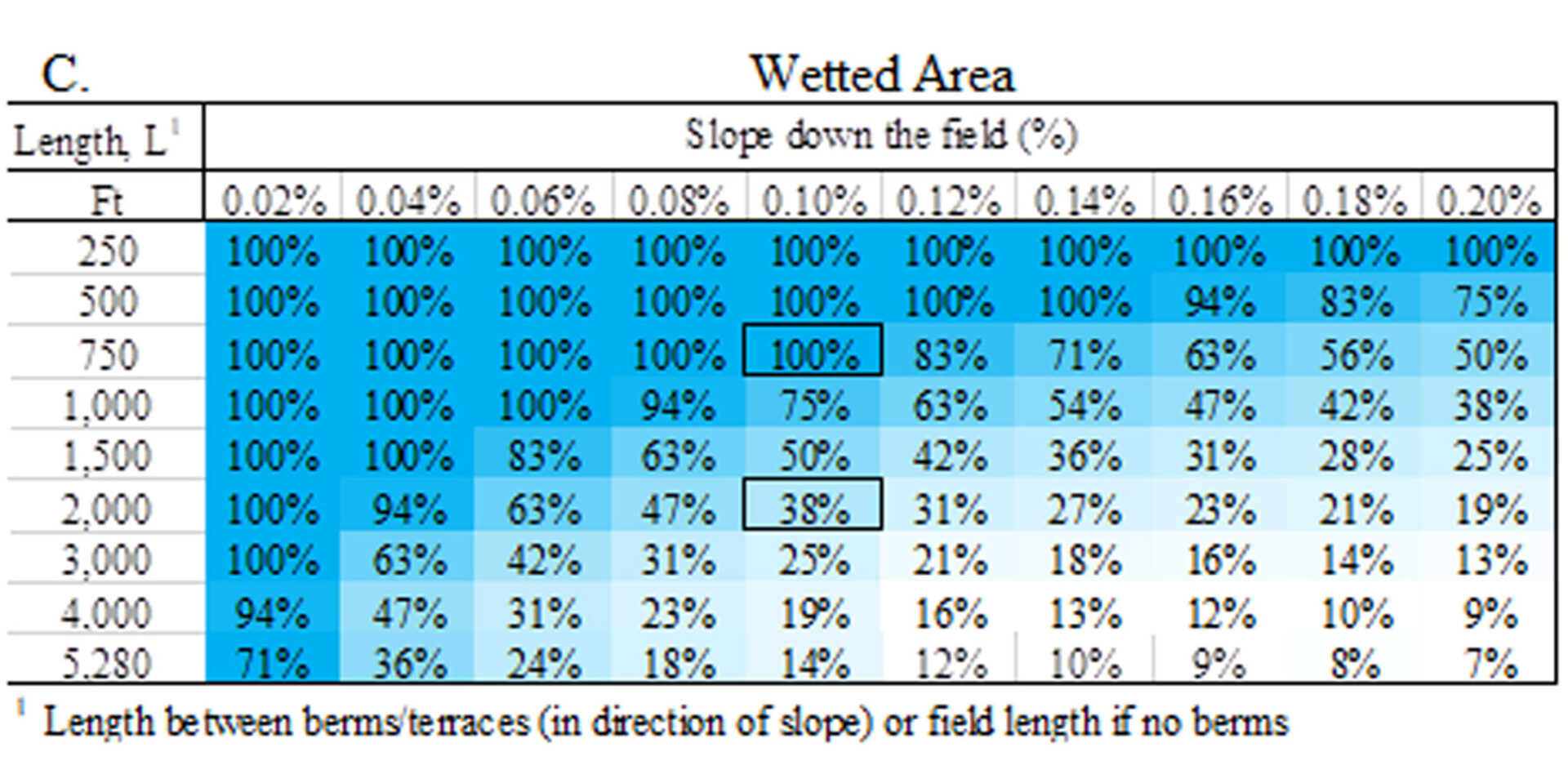
Soil Oxygen Levels, Management and Crop Health
We monitored surface water height, soil moisture and oxygen (O2) levels during OFR (Figure 5) shows example of monitored results.) The oxygen partial pressure at sea level is about 21 kilopascals (kPa), a level we observed in the soil before OFR. For fruit and nut trees, soil O2 of more than 10 kPa is optimal and O2 less than 5 kPa is potentially compromising (UC Davis, 2014). We used 5 kPa to define low O2 that may be harmful to tree health.
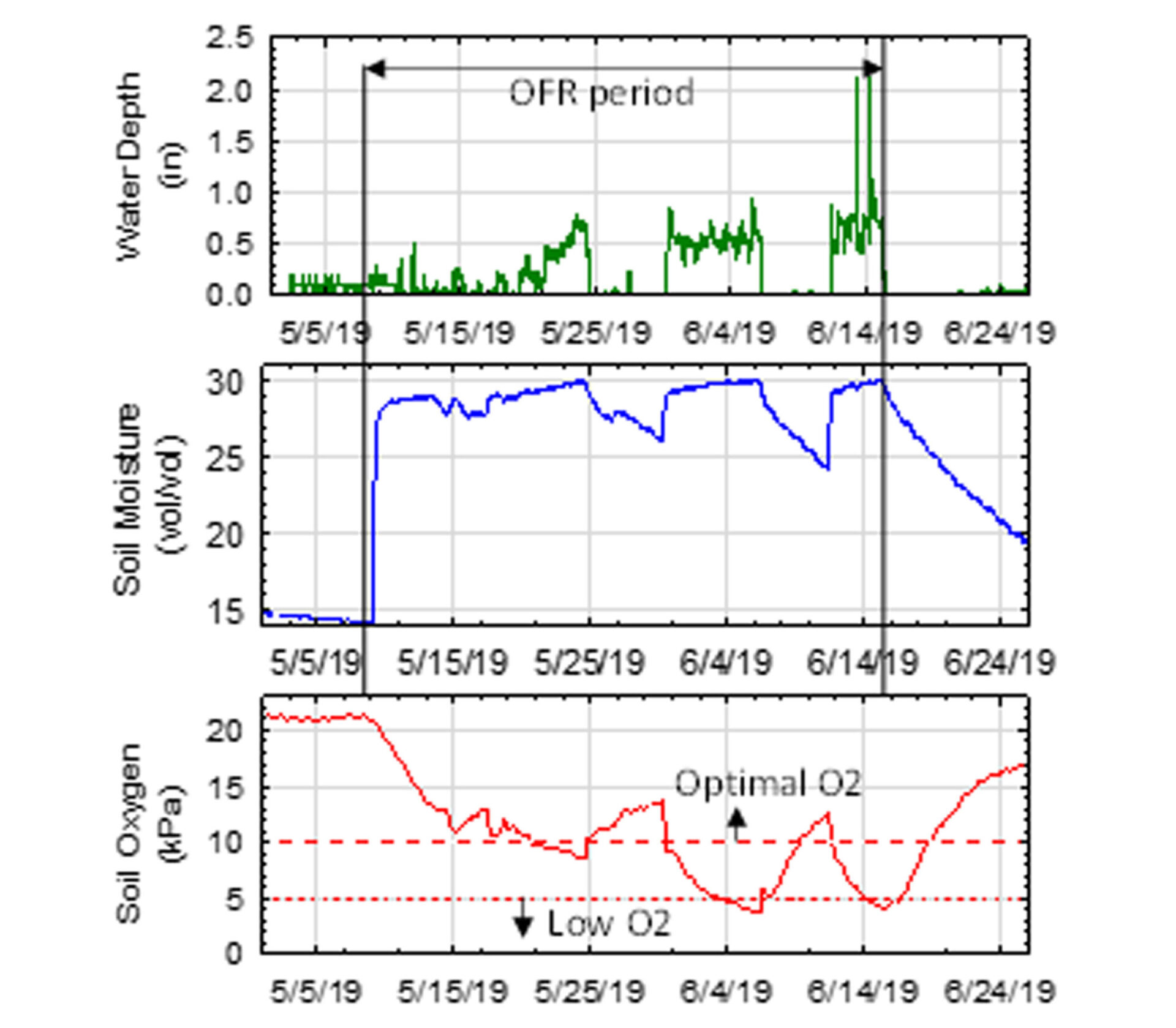
When flooded, soil moisture increased and, after about one day, water infiltrated down below four feet. About one to two hours after soil moisture increased, O2 levels begin to drop at a rate of 0.7 to 1.5 kPa/day. When water was turned off, soil moisture began dropping and O2 began increasing. About one day after standing water was gone, and as soil moisture neared field capacity, O2 started to rebound at a rate of about 1 to 2 kPa/day.
Plots receiving continuous and alternating flooding recorded low O2 levels for a maximum of 10 days in 2020 (Table 1). Over-irrigated and regularly irrigated treatments both experienced very short periods of low O2 (0 to 0.2 days).
Unexpectedly, the continuously flooded plot 19W experienced fewer days of low O2 than the alternating flooded 19E plot in both years. Available soil borings indicate this occurred because 19W is underlain by a thick, highly permeable layer of sand with gravel starting just below four feet, while at 19E, the permeable layer starts farther below the root zone. Soil conditions in and near the root zone that led to free water drainage also kept soil oxygen levels relatively high.
Durations of low O2 can be controlled through water management. At alternating treatment plot 19E, O2 levels recovered during drying periods and helped shorten the duration at low O2 (Figure 5). Results also suggest that alternate row flooding may keep O2 slightly higher than flooding of larger blocks. Monitoring station 19E-A, located at the boundary of the subplots, shows conditions expected under alternating row flooding. In both 2019 and 2020, 19E-A experienced shorter durations of low O2 than monitored station 19E-P, located in the middle of a subplot (Table 1).
Interest in soil O2 levels is driven by concern for crop health and production. We evaluated tree health in all plots using visual assessments, leaf nutrient analyses, stem water potential analyses and yield comparisons, and did not observe adverse effects due to OFR on pecan health.
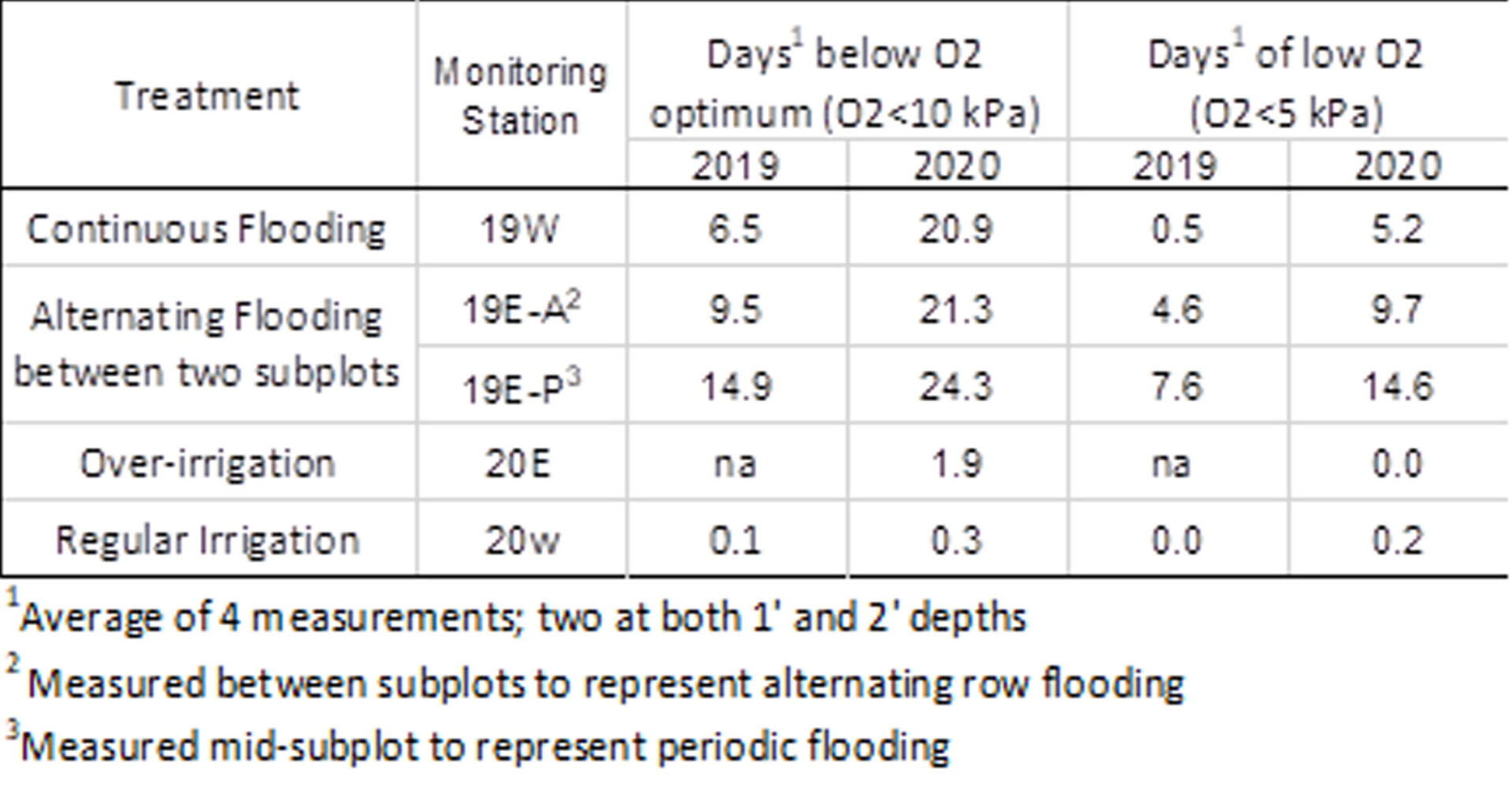
OFR Costs
The cost of OFR equipment installation and operation will vary significantly depending on the situation. We use two scenarios to illustrate OFR costs based on the work done in the pecan orchard. In Scenario 1, an operational irrigation system for distributing water is in place, and the grower only builds berms in and around the orchard and pays for an irrigator working two hours per day. Scenario 2 is the same as Scenario 1, except the grower also installs a connection to a nearby turnout and a poly pipe system for water delivery as was done in this pilot study. To conduct OFR for six weeks, Scenario 1 costs $21/acre and Scenario 2 costs $46/acre. We also calculated OFR costs for the scenarios operating 2 and 10 weeks, and with terracing.
While total OFR costs are important, a grower’s goal is likely to minimize cost per unit volume of recharged water. Therefore, we standardized total costs to factors proportional to recharge volume for a given field: OFR duration and wetted area. Because of mobilization costs, the standardized cost (OFR cost/wetted area/week) drops with longer OFR duration (Figure 6). Additionally, although terraces increase total cost, they reduce the standardized cost because they increase the wetted area for infiltration. Terraces are particularly useful in increasing cost efficiency when the initial set-up costs are greater (Scenario 2).
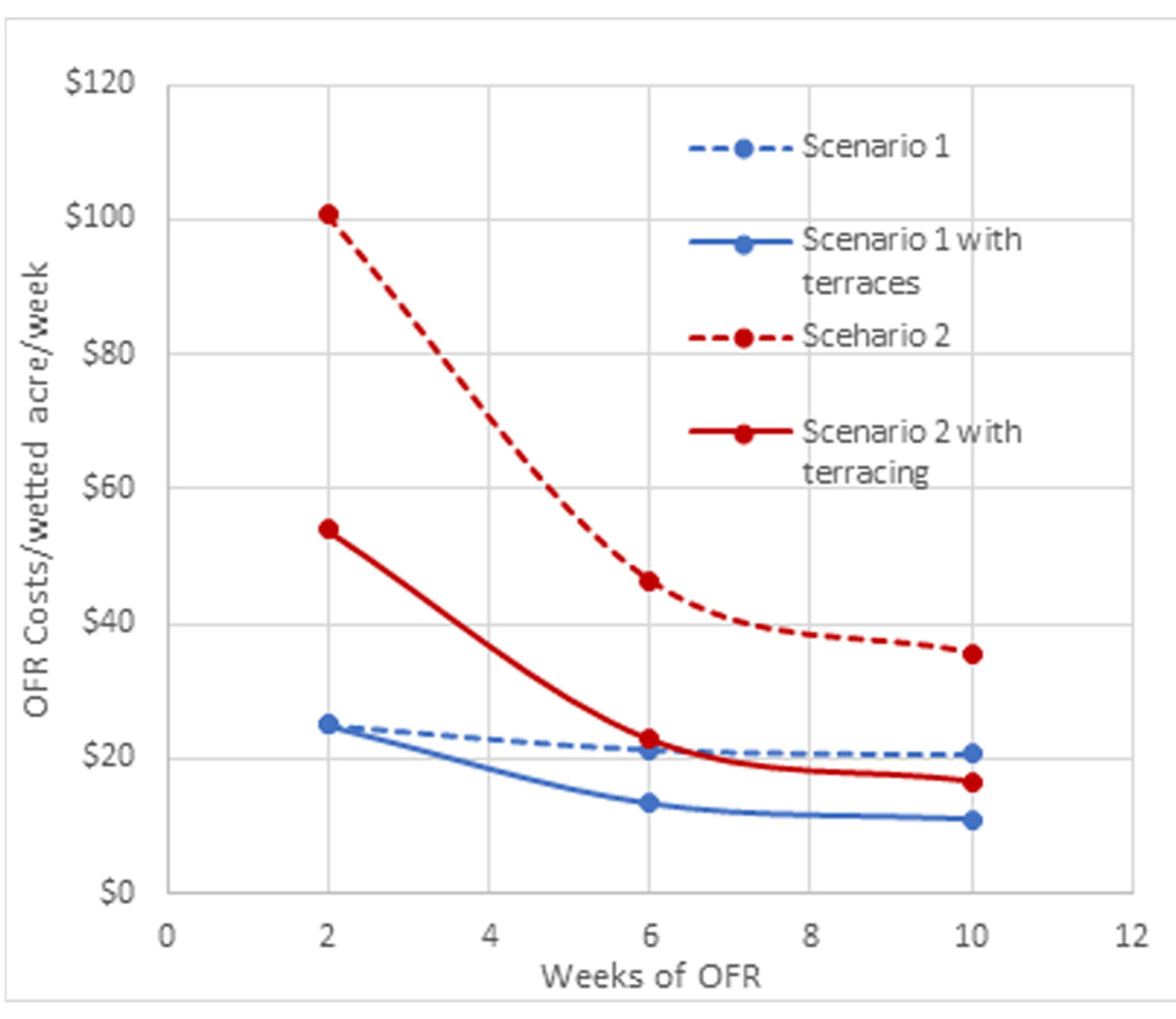
Conclusions
During a 46-day period in 2020, 40 feet of water was applied to a 5.4-acre pecan plot without causing adverse effects to tree health and yield, even though soil oxygen levels dropped to low levels for several days. A grower with crops more sensitive to low O2 conditions may want to keep O2 levels higher. To keep O2 levels as high as possible, a grower should conduct OFR on their most permeable available areas. Also, alternating flooding helps to keep O2 levels higher by allowing O2 to recover. More research is needed to study the effect of OFR on tree health and productivity, especially in other orchard systems, such as addressing short- and long-term effects on orchard longevity and growers’ concerns regarding tree health, such as root and crown diseases. For more detailed information on OFR practices, pecan tree health under OFR and costs to grow pecans and operate OFR, please see bachandassociates.com/projects/groundwater-recharge/pecan-farm-recharge.
References
University of California., 2014. Presentation at 2014 Pomology Extension Course given 2/25/14. Retrieved from http://fruitandnuteducation.ucdavis.edu/files/184640.pdf 8/28/21.







